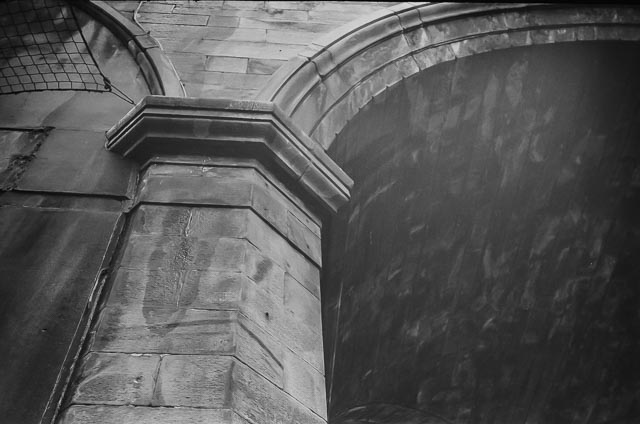Kiev Automat series

Most of the Soviet cameras that were imported into the United Kingdom (and the West in general) where pretty boring designs that were either very basic (such as the Zenit series of SLR cameras) or slavish copies of German designs (such as the Kiev rangefinder cameras which were pretty much screw-for-screw copies of Contax rangefinders). But the Soviets also made some rather more interesting designs which they kept largely for themselves.
Perhaps the best example is the Kiev Automat series of cameras made between 1964 and 1980 by the Arsenal factory in Ukraine. Unlike many other Soviet designs, these camera were both innovative and highly advanced for their time.
There were just two cameras in the series, the Kiev 10 introduced in 1964, and it's successor, the Kiev 15 introduced in 1973. Actually there are several clues that the Kiev 10 and 15 models were heavily influenced by the Contarex SLRs from Zeiss Ikon in Germany. For example, note that there is no aperture ring on the lens… instead the aperture is controlled by a dial on the camera body just like on a Contarex. But unlike the Kiev rangefinders the Kiev Automat SLR cameras combined the Zeiss Ikon influence with plenty of impressive home-grown engineering.
One of the most intriguing bits of Ukrainian engineering in both the 10 and the 15 is the very unusual, and rather beautiful, fan shaped metal shutter illustrated in the video to the right.
And these cameras were far more advanced than the designs commonly exported to the West. The Kiev 10 was launched in 1964 with an automatic aperture diaphragm and shutter speed priority automatic exposure (combined with selenium cell exposure meter above the lens… quite possibly the world's first SLR camera with fully interchangeable lenses to feature automatic exposure!). In 1973 the 10 was replaced by the 15 which replaced the selenium cell meter with through-the-lens open-aperture metering. All this automation was achieved with purely mechanical coupling between lens and camera… not bad for the 1960s and 70s!
Even though the Kiev 10 and 15 cameras were made over a 16 year period, there were only ever 5 lenses made for the Kiev Automat mount, but it was a very useful range never-the-less: 20mm f/3.5, 37mm f/2.8, 50mm f/2, 85mm f/2 and 135mm f/4.
Kiev 10 Automat
 Of the two Kiev Automat cameras, by far and away my favourite is the Kiev 10 Automat… I mean just look at it! It looks like a prop from the coolest 1960s sci-fi show imaginable ;-) It is exactly what a retro-futuristic 1960s camera should look like! And the 10 has much sleeker and cleaner styling than the later 15. The top plate is almost free from any controls other than the shutter button and the shutter speed/film speed dial. My Kiev 10 is far from mint, but it's in good useable condition. The only major cosmetic problem is a ding in the pentaprism, but this doesn't seem to affect the functionality.
Of the two Kiev Automat cameras, by far and away my favourite is the Kiev 10 Automat… I mean just look at it! It looks like a prop from the coolest 1960s sci-fi show imaginable ;-) It is exactly what a retro-futuristic 1960s camera should look like! And the 10 has much sleeker and cleaner styling than the later 15. The top plate is almost free from any controls other than the shutter button and the shutter speed/film speed dial. My Kiev 10 is far from mint, but it's in good useable condition. The only major cosmetic problem is a ding in the pentaprism, but this doesn't seem to affect the functionality.
The other reason I prefer the Kiev 10 over the Kiev 15 is that it's much easier to use. The film speed dial is marked in both German DIN and Soviet GOST numbers. Neither of these is as familiar in the West as ASA/ISO numbers, but in western Europe film is still usually marked in both ISO and DIN numbers, so setting the film speed is still easy enough. The 15 has a film speed dial only marked in the GOST numbers commonly used in eastern Europe. And while the Kiev 15 has dials marked with frustratingly cryptic differently coloured and sized (but otherwise unlabelled!) dots, the Kiev 10 has dials clearly marked with numbers and letters. I was able to get the 10 set up and ready to go with out the instruction manual. Just as well, as I've never seen an English instruction manual for either of these cameras!
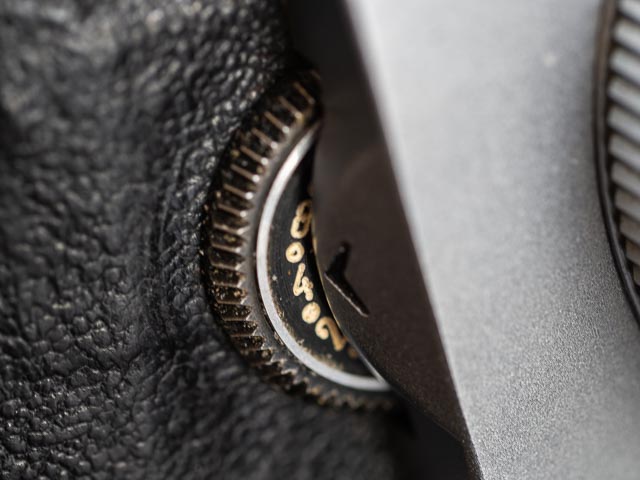
 As mentioned above, Kiev Automat lenses have no aperture control. On the Kiev 10 the aperture control is located to the left of the lens (looking at the camera from the front).
As mentioned above, Kiev Automat lenses have no aperture control. On the Kiev 10 the aperture control is located to the left of the lens (looking at the camera from the front).
The viewfinder has a needle to indicate the aperture selected by the camera, or the recommended aperture for use in manual mode. The only problem I've had with the 10 is that it doesn't seem too happy with the 37mm lens. There is heavy vignetting in the viewfinder and it remains to be seen whether this is apparent on the photos too. (The 37mm lens produces no vignetting on the viewfinder on the 15.)
The rewind crank and rewind release button and back-opening button are all on the bottom of the camera. With the 50mm f/2.0 lens attached the Kiev 10 weighs in at a hefty 1028 grams.




Was the Kiev 10 Automat the world's SLR with fully interchangeable lenses and automatic exposure?
I'm going to go out on a limb here and say yes! But does Ukraine ever get any credit for this amazing feat of photographic engineering? Nope! Let's look at some of the competitors for this title:
-
1961 Royer Savoyflex Automatic
Launched by the French Royer company in 1961, this is the camera that often gets the nod as the first automatic exposure SLR. But the Savoyflex was a leaf shutter camera that didn't have fully interchangeable lenses. Much like the Zeiss Ikon Contaflex series, which it resembled, you could only remove the front element of the standard 50mm lens and replace it with a limited range of partial lens modules.
-
1965 Contaflex Super BC
Like the Savoyflex, this was a leaf shutter SLR camera that featured only partially interchangeable lenses. What's more this camera was introduced in 1965, 1 year after the Kiev 10 Automat.
-
1966 Konica Auto Reflex
Ahh… now we're getting close. The Konica Auto Reflex was a real focal plane shutter SLR with shutter speed priority automatic exposure and fully interchangeable lenses. And it has a unique trick up it's sleeve: you could switch it between full frame and half frame at will! But it was introduced 2 years after the Kiev 10 Automat in 1966. (Some reports say this camera was launched in 1965, but that's still after the Kiev 10!)
If you know of any SLR cameras with fully interchangeable lenses and automatic exposure, launched in 1964 or before, I would love to hear from you!
Kiev 15 Automat
 In 1973 the Kiev 10 was replaced by the Kiev 15. This camera replaced the selenium cell meter above the pentaprism with through-the-lens open-aperture metering. This was at a time when such things we still quite rare even on the latest cameras to come out of Japan. But today this produces problems… you will be very lucky indeed to find a Kiev 15 with working metering. On my model, the battery compartment is thoroughly green and corroded. Soviet batteries were very prone to leaks! But given that the controls of the 15 are strewn with differently coloured/sized unlabelled dots which, without the aid of a manual, I have been unable to decipher, it is probably just as well the metering system isn't working (other than the metering system this example seems to be in fine working order). None of the listings of this camera I have seen on eBay have indicated that the metering system is working.
In 1973 the Kiev 10 was replaced by the Kiev 15. This camera replaced the selenium cell meter above the pentaprism with through-the-lens open-aperture metering. This was at a time when such things we still quite rare even on the latest cameras to come out of Japan. But today this produces problems… you will be very lucky indeed to find a Kiev 15 with working metering. On my model, the battery compartment is thoroughly green and corroded. Soviet batteries were very prone to leaks! But given that the controls of the 15 are strewn with differently coloured/sized unlabelled dots which, without the aid of a manual, I have been unable to decipher, it is probably just as well the metering system isn't working (other than the metering system this example seems to be in fine working order). None of the listings of this camera I have seen on eBay have indicated that the metering system is working.

 On the Kiev 15 the aperture control moved to the upper right hand side of the camera (when looking at the camera from the font). This makes it rather easier to reach the aperture control than on the Kiev 10. Here you can see the control set to A for automatic and 4 for f/4.0. One other thing the 15 adds to the specification of the 10 is a hot-shoe for flash.
On the Kiev 15 the aperture control moved to the upper right hand side of the camera (when looking at the camera from the font). This makes it rather easier to reach the aperture control than on the Kiev 10. Here you can see the control set to A for automatic and 4 for f/4.0. One other thing the 15 adds to the specification of the 10 is a hot-shoe for flash.
As with the Kiev 10 the rewind crank rewind release button and back opening button are all on the base-plate, along with the battery compartment. With the 50mm f/2.0 lens attached the Kiev 15 weighs in at an even heftier 1107 grams.
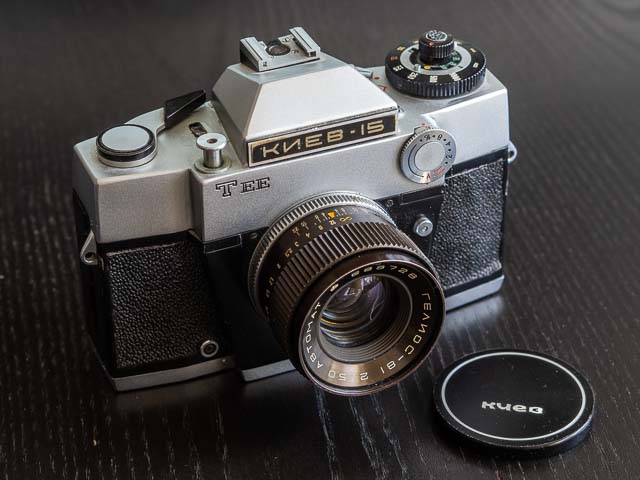



My Kiev Automat system
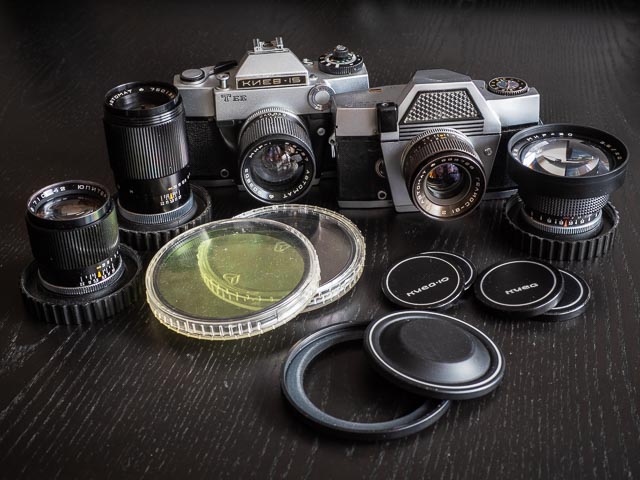 There were only ever 2 cameras and 5 lenses in the Kiev Automat series, which makes it a nice system to collect as you can collect the whole lot pretty easily. But even though there is a limited number of lenses, it is never-the-less a very useful range: 20mm f/3.5, 37mm f/2.8, 50mm f/2, 85mm f/2 and 135mm f/4. Strictly speak it could be said that there were 6 lenses as there was an earlier version of the 50mm f/2.0 lens called the Helios-65, but the differences seem to be only a matter of styling.
There were only ever 2 cameras and 5 lenses in the Kiev Automat series, which makes it a nice system to collect as you can collect the whole lot pretty easily. But even though there is a limited number of lenses, it is never-the-less a very useful range: 20mm f/3.5, 37mm f/2.8, 50mm f/2, 85mm f/2 and 135mm f/4. Strictly speak it could be said that there were 6 lenses as there was an earlier version of the 50mm f/2.0 lens called the Helios-65, but the differences seem to be only a matter of styling.
One strange thing about the Automat lenses is that it seems that at no point were rear lens caps made for them! But they were supplied in clear plastic 'bubble' style cases that had bottom covers that can be used as (rather bulky) rear lens caps, so if you're buying an Automat lenses make sure it comes with its bubble case.
Mir-20 20mm f/3.5 Automat
This is one serious hunk of glass! In the 1960s ultra-wide angle lenses were still quite rare and their design was still at an early stage. The Mir-20 has a bulbous front element that means filters cannot be fitted without an adapter (that allows massive 95mm filters to be used). My lens came with two such filters, a yellow/green one for adding a bit of extra contrast with black and white film, and a clear protective filter. Unfortunately the clear filter is completely stuck in its case! The Mir-20 weighs in at 374 grams.


Mir-1 37mm f/2.8 Automat
The next lens in the Automat system is a 37mm moderate wide-angle lens. Apart from the huge 20mm ultra-wide angle lens, most the Automat lenses take standard 49mm filter, so it's a little frustrating that the 37mm takes 52mm filters. The Mir-1 weighs in at 224 grams.


Helios-81 50mm f/2.0 Automat
The standard lens of the Automat system is a 50mm f/2.0 design. The Helios-81 weighs in at 192 grams and takes standard 49mm filters.


Jupiter-9 85mm f/2.0 Automat
The Jupiter-9 is a very handy and compact 'portrait' lens. It weighs in at 293 grams and takes standard 49mm filters.

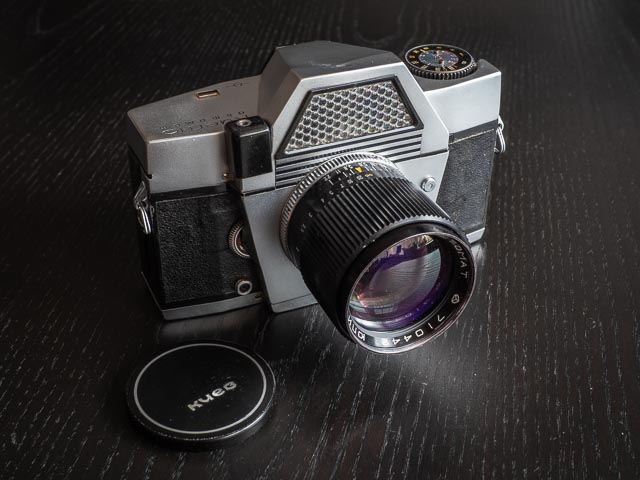
Jupiter-11 135mm f/4.0 Automat
The telephoto lens in the Automat system is a fairly slow 135mm f/4.0 design. It has a useful built-in lens hood. The Jupiter-11 weighs in at 378 grams and takes standard 49mm filters.


Photographs taken with the Kiev 10
Below are some photographs from my first film in the Kiev 10. There were all shot on Kentmere 400 film in Edinburgh using either the 50mm or 20mm lenses.




